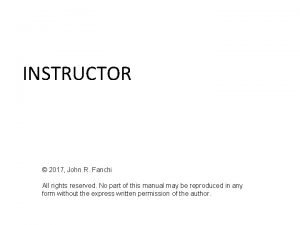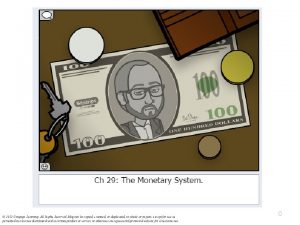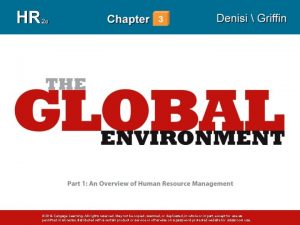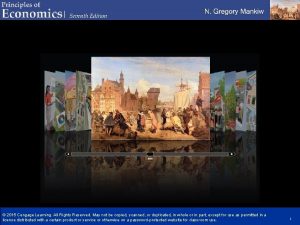2011 Cengage Learning All Rights Reserved May not















































- Slides: 47

© 2011 Cengage Learning. All Rights Reserved. May not be copied, scanned, or duplicated, in whole or in part, except for use as permitted in a license distributed with a certain product or service or otherwise on a password‐protected website for classroom use 1

The International Economy and Globalization Power. Point slides prepared by: Andreea Chiritescu Eastern Illinois University © 2011 Cengage Learning. All Rights Reserved. May not be copied, scanned, or duplicated, in whole or in part, except for use as permitted in a license distributed with a certain product or service or otherwise on a password‐protected website for classroom use 2

The International Economy • High degree of economic interdependence • No nation exists in economic isolation • All aspects of a nation’s economy are linked to the economies of its trading partners • Reflects the historical evolution of the world’s economic and political order • Complex and its effects uneven © 2011 Cengage Learning. All Rights Reserved. May not be copied, scanned, or duplicated, in whole or in part, except for use as permitted in a license distributed with a certain product or service or otherwise on a password‐protected website for classroom use 3

The International Economy • High degree of economic interdependence • Steps toward international cooperation • Mutually advantageous for trading nations • Specialization, efficiencies of large scale production • Wider variety of products at lower cost • Protectionist pressures • Developing nations • Liberalized trading system ‐ serves to keep the developing nations in poverty © 2011 Cengage Learning. All Rights Reserved. May not be copied, scanned, or duplicated, in whole or in part, except for use as permitted in a license distributed with a certain product or service or otherwise on a password‐protected website for classroom use 4

Globalization of Economic Activity • Globalization • Greater interdependence • Countries and their citizens • International flows • Goods and services • People • Investments in equipment, factories, stocks, bonds • Non‐economic elements • Culture and the environment © 2011 Cengage Learning. All Rights Reserved. May not be copied, scanned, or duplicated, in whole or in part, except for use as permitted in a license distributed with a certain product or service or otherwise on a password‐protected website for classroom use 5

Globalization of Economic Activity • What forces are driving globalization? • Technological change • Multilateral trade negotiations • Continuing liberalization of trade and investment • Widespread liberalization of investment transactions • Development of international financial markets © 2011 Cengage Learning. All Rights Reserved. May not be copied, scanned, or duplicated, in whole or in part, except for use as permitted in a license distributed with a certain product or service or otherwise on a password‐protected website for classroom use 6

Waves of Globalization • First Wave of Globalization: 1870– 1914 • Decreases in tariff barriers & new technologies • Declining transportation costs • Shift from sail to steamships; Railways • Driven by European and American businesses and individuals © 2011 Cengage Learning. All Rights Reserved. May not be copied, scanned, or duplicated, in whole or in part, except for use as permitted in a license distributed with a certain product or service or otherwise on a password‐protected website for classroom use 7

Waves of Globalization • First Wave of Globalization: 1870– 1914 • Exports as a share of world income • Nearly doubled to 8% • Per capita incomes increased 1. 3% per year • Previous 50 years: 0. 5% per year • Countries that actively participated in globalization • Became the richest countries in the world • Brought to an end by World War I © 2011 Cengage Learning. All Rights Reserved. May not be copied, scanned, or duplicated, in whole or in part, except for use as permitted in a license distributed with a certain product or service or otherwise on a password‐protected website for classroom use 8

Waves of Globalization • Great Depression of the 1930 s • Governments – protectionism • Tariffs on imports • Try to shift demand into domestic markets • Promote sales for domestic companies • Promote jobs for domestic workers • Exports as a share of national income • Falls to 5% © 2011 Cengage Learning. All Rights Reserved. May not be copied, scanned, or duplicated, in whole or in part, except for use as permitted in a license distributed with a certain product or service or otherwise on a password‐protected website for classroom use 9

Waves of Globalization • Second Wave of Globalization: 1945– 1980 • • Horrors of the retreat into nationalism Falling transportation costs Decrease previously established trade barriers Trade liberalization – discrimination • Which countries participated • Which products were included © 2011 Cengage Learning. All Rights Reserved. May not be copied, scanned, or duplicated, in whole or in part, except for use as permitted in a license distributed with a certain product or service or otherwise on a password‐protected website for classroom use 10

Waves of Globalization • Trade liberalization – discrimination • Developed countries, manufactured goods • Largely freed of barriers • Greatly increased the exchange of manufactured goods • Raise the incomes of developed countries • Developing countries • Eliminate barriers only for those agricultural products that did not compete with agriculture in developed countries • Manufactured goods ‐ sizable barriers © 2011 Cengage Learning. All Rights Reserved. May not be copied, scanned, or duplicated, in whole or in part, except for use as permitted in a license distributed with a certain product or service or otherwise on a password‐protected website for classroom use 11

Waves of Globalization • Second Wave of Globalization: 1945– 1980 • New kind of trade • Rich country specialization in manufacturing niches • Gained productivity through agglomeration economies • Firms clustered together • Some clusters produced the same product • Others were connected by vertical linkages • Agglomeration economies • Benefit those in the clusters • Bad news for those who are left out © 2011 Cengage Learning. All Rights Reserved. May not be copied, scanned, or duplicated, in whole or in part, except for use as permitted in a license distributed with a certain product or service or otherwise on a password‐protected website for classroom use 12

Waves of Globalization • Second Wave of Globalization: 1945– 1980 • Most developing countries • Did not participate in the growth of global trade in manufacturing and services • Continuing trade barriers in developed countries • Unfavorable investment climates • Antitrade policies in developing countries • Dependence on agricultural and natural‐resource products © 2011 Cengage Learning. All Rights Reserved. May not be copied, scanned, or duplicated, in whole or in part, except for use as permitted in a license distributed with a certain product or service or otherwise on a password‐protected website for classroom use 13

Waves of Globalization • Second Wave of Globalization: 1945– 1980 • Increased per capita incomes within the developed countries • Developing countries as a group were being left behind • World inequality © 2011 Cengage Learning. All Rights Reserved. May not be copied, scanned, or duplicated, in whole or in part, except for use as permitted in a license distributed with a certain product or service or otherwise on a password‐protected website for classroom use 14

Waves of Globalization • Latest Wave of Globalization, began in 1980 • A large number of developing countries • China, India, and Brazil • Broke into the world markets for manufacturers • Other developing countries • Increasingly marginalized in the world economy • Decreasing incomes • Increasing poverty • Significant international capital movements © 2011 Cengage Learning. All Rights Reserved. May not be copied, scanned, or duplicated, in whole or in part, except for use as permitted in a license distributed with a certain product or service or otherwise on a password‐protected website for classroom use 15

Waves of Globalization • Latest Wave of Globalization, began in 1980 • Some developing countries • Competitive advantage in labor‐intensive manufacturing • Bangladesh, Malaysia, Turkey, Mexico, Hungary, Indonesia, Sri Lanka, Thailand, and the Philippines • Tariff cuts • Lower barriers to foreign investment • Technological progress in transportation and communications • Protectionist policies in developed countries © 2011 Cengage Learning. All Rights Reserved. May not be copied, scanned, or duplicated, in whole or in part, except for use as permitted in a license distributed with a certain product or service or otherwise on a password‐protected website for classroom use 16

Waves of Globalization • Latest Wave of Globalization, began in 1980 • World • More globalized ‐ international trade, capital flows • Less globalization ‐ labor flows • Foreign outsourcing • Certain aspects of a product’s manufacture are performed in more than one country • Manufacturing ‐ moved to wherever costs were the lowest • Job losses for blue‐collar workers • Cries for the passage of laws to restrict outsourcing © 2011 Cengage Learning. All Rights Reserved. May not be copied, scanned, or duplicated, in whole or in part, except for use as permitted in a license distributed with a certain product or service or otherwise on a password‐protected website for classroom use 17

TABLE 1. 1 Manufacturing an HP Pavilion, ZD 8000 laptop computer © 2011 Cengage Learning. All Rights Reserved. May not be copied, scanned, or duplicated, in whole or in part, except for use as permitted in a license distributed with a certain product or service or otherwise on a password‐protected website for classroom use 18

Waves of Globalization • Latest Wave of Globalization, began in 1980 • By the 2000 s, foreign outsourcing of white‐ collar work • Information Age • Digitization, Internet, and high‐speed data networks around the world • Sending upscale jobs offshore • Accounting, chip design, engineering, basic research, and financial analysis • Foreign outsourcing • Reduce costs of a given service: 30 to 50% © 2011 Cengage Learning. All Rights Reserved. May not be copied, scanned, or duplicated, in whole or in part, except for use as permitted in a license distributed with a certain product or service or otherwise on a password‐protected website for classroom use 19

TABLE 1. 2 Globalization goes white collar © 2011 Cengage Learning. All Rights Reserved. May not be copied, scanned, or duplicated, in whole or in part, except for use as permitted in a license distributed with a certain product or service or otherwise on a password‐protected website for classroom use 20

The United States as an Open Economy • Trade patterns • Openness • Rough measure of the importance of international trade in a nation’s economy • Nation’s exports and imports as a percentage of its gross domestic product (GDP) © 2011 Cengage Learning. All Rights Reserved. May not be copied, scanned, or duplicated, in whole or in part, except for use as permitted in a license distributed with a certain product or service or otherwise on a password‐protected website for classroom use 21

The United States as an Open Economy • Openness • Large countries – lower measures of openness • Less reliant on international trade • Many of their companies can attain an optimal production size without having to export to foreign nations • Small countries – higher measures of openness © 2011 Cengage Learning. All Rights Reserved. May not be copied, scanned, or duplicated, in whole or in part, except for use as permitted in a license distributed with a certain product or service or otherwise on a password‐protected website for classroom use 22

TABLE 1. 4 Exports & imports of goods & services, percentage of GDP, 2007 © 2011 Cengage Learning. All Rights Reserved. May not be copied, scanned, or duplicated, in whole or in part, except for use as permitted in a license distributed with a certain product or service or otherwise on a password‐protected website for classroom use 23

FIGURE 1. 1 Openness of the U. S. economy, 1890– 2007 The figure shows that for the United States the importance of international trade has increased by more than 50 percent from 1890 to the early 2000 s. © 2011 Cengage Learning. All Rights Reserved. May not be copied, scanned, or duplicated, in whole or in part, except for use as permitted in a license distributed with a certain product or service or otherwise on a password‐protected website for classroom use 24

TABLE 1. 5 Leading trade partners of the U. S. , 2008 © 2011 Cengage Learning. All Rights Reserved. May not be copied, scanned, or duplicated, in whole or in part, except for use as permitted in a license distributed with a certain product or service or otherwise on a password‐protected website for classroom use 25

The United States as an Open Economy • International banking • Average daily turnover in foreign‐exchange market • Today: almost $2 trillion • 1986: $205 billion • London ‐ the largest center foreign‐ exchange trading © 2011 Cengage Learning. All Rights Reserved. May not be copied, scanned, or duplicated, in whole or in part, except for use as permitted in a license distributed with a certain product or service or otherwise on a password‐protected website for classroom use 26

The United States as an Open Economy • Commercial banking • U. S. banks • Worldwide branch networks, 1960 s and 1970 s • Loans, payments, foreign‐exchange trading • Foreign banks • Increased presence in U. S. , 1980 s and 1990 s • Today: 250 foreign banks • Securities firms ‐ globalized their operations • By 1980 s, U. S. government securities • Traded on a 24‐hour basis © 2011 Cengage Learning. All Rights Reserved. May not be copied, scanned, or duplicated, in whole or in part, except for use as permitted in a license distributed with a certain product or service or otherwise on a password‐protected website for classroom use 27

Why Is Globalization Important? • Law of comparative advantage • Citizens of each nation can gain • Spend more of their time and resources doing those things in which they have a relative advantage • If a good or service can be obtained more economically through trade • Trade for it instead of producing it domestically • How the available resources can be used to obtain each good at the lowest possible cost © 2011 Cengage Learning. All Rights Reserved. May not be copied, scanned, or duplicated, in whole or in part, except for use as permitted in a license distributed with a certain product or service or otherwise on a password‐protected website for classroom use 28

Why Is Globalization Important? • Open economies • Produce a larger joint output • Competition ‐ essential to both innovation and efficient production • International competition • Domestic producers ‐ strong incentive to improve the quality of their products • Weakens monopolies © 2011 Cengage Learning. All Rights Reserved. May not be copied, scanned, or duplicated, in whole or in part, except for use as permitted in a license distributed with a certain product or service or otherwise on a password‐protected website for classroom use 29

FIGURE 1. 2 Global competition lowers inflation World imports relative to U. S. consumption have doubled over the past four decades, making more of what consumers purchase subject to increased competition inherent in international trade. This added competition tends to hold down the cost of goods and services as seen for the period 1987 to 2003. © 2011 Cengage Learning. All Rights Reserved. May not be copied, scanned, or duplicated, in whole or in part, except for use as permitted in a license distributed with a certain product or service or otherwise on a password‐protected website for classroom use 30

Why Is Globalization Important? • Open economies • More competition • More firm turnover • Improvements for the industry • Economic growth rates ‐ close relation to: • Openness to trade • Education • Communications infrastructure © 2011 Cengage Learning. All Rights Reserved. May not be copied, scanned, or duplicated, in whole or in part, except for use as permitted in a license distributed with a certain product or service or otherwise on a password‐protected website for classroom use 31

FIGURE 1. 3 Tariff barriers versus economic growth The figure shows the weighted average tariff rate and per‐capita growth rate in GDP for 23 nations in 2002. According to the figure, there is evidence of an inverse relationship between the level of tariff barriers and the economic growth of nations. © 2011 Cengage Learning. All Rights Reserved. May not be copied, scanned, or duplicated, in whole or in part, except for use as permitted in a license distributed with a certain product or service or otherwise on a password‐protected website for classroom use 32

Why Is Globalization Important? • Globalization • Rapid growth in some countries • Increased demand for commodities • Crude oil, cooper, steel ‐ higher prices • Increased supply of substitutes • Biodiesel, ethanol • Domestic economy • Vulnerable to disturbances initiated overseas • Increased competition from abroad • Schwinn Bicycle Company, Dell Computer Corporation © 2011 Cengage Learning. All Rights Reserved. May not be copied, scanned, or duplicated, in whole or in part, except for use as permitted in a license distributed with a certain product or service or otherwise on a password‐protected website for classroom use 33

GLOBALIZATION The Global Recession of 2007 – 2009 • Immediate cause of the global economic crisis • Collapse of the U. S. housing market • Resulting surge in mortgage loan defaults • Undermined the financial institutions that originated and invested in them • Creditors and uninsured depositors • Pulled their funds and cashed out of securities issued by risky institutions • Invested in U. S. Treasury securities © 2011 Cengage Learning. All Rights Reserved. May not be copied, scanned, or duplicated, in whole or in part, except for use as permitted in a license distributed with a certain product or service or otherwise on a password‐protected website for classroom use 34

GLOBALIZATION The Global Recession of 2007 – 2009 • Immediate cause of the global economic crisis • Many institutions failed, others struggled to survive • Banks ‐ fearful about making loans • The credit spigot closed • The global economy withered • Global stock investors dumped their holdings • Self‐reinforcing adverse economic downturn • Crisis in confidence © 2011 Cengage Learning. All Rights Reserved. May not be copied, scanned, or duplicated, in whole or in part, except for use as permitted in a license distributed with a certain product or service or otherwise on a password‐protected website for classroom use 35

GLOBALIZATION The Global Recession of 2007 – 2009 • Roots of the problem • Lack of fear ‐ booming housing market of 2006 • Mortgage‐backed securities • Booming housing market • Government pressured banks to serve poor borrowers and poor regions of the country • Community Reinvestment Act • Default mortgages © 2011 Cengage Learning. All Rights Reserved. May not be copied, scanned, or duplicated, in whole or in part, except for use as permitted in a license distributed with a certain product or service or otherwise on a password‐protected website for classroom use 36

GLOBALIZATION The Global Recession of 2007 – 2009 • Combating a crisis in confidence • Governments • Large fiscal stimulus packages • Tax cuts • Increased government spending • International Monetary Fund • Financial aid to emerging countries © 2011 Cengage Learning. All Rights Reserved. May not be copied, scanned, or duplicated, in whole or in part, except for use as permitted in a license distributed with a certain product or service or otherwise on a password‐protected website for classroom use 37

Common Fallacies of International Trade • “Trade is a zero‐sum activity” • Both partners gain from trade • “Imports reduce employment and act as a drag on the economy, while exports promote growth and employment” • Failure to consider the link between imports and exports © 2011 Cengage Learning. All Rights Reserved. May not be copied, scanned, or duplicated, in whole or in part, except for use as permitted in a license distributed with a certain product or service or otherwise on a password‐protected website for classroom use 38

Common Fallacies of International Trade • “Tariffs, quotas, and other import restrictions will save jobs and promote a higher level of employment” • Failure to recognize that a reduction in imports does not occur in isolation • Free trade • Increases competition, lowers prices • Makes better products available to consumers • Higher consumption © 2011 Cengage Learning. All Rights Reserved. May not be copied, scanned, or duplicated, in whole or in part, except for use as permitted in a license distributed with a certain product or service or otherwise on a password‐protected website for classroom use 39

Is International Trade an Opportunity or a Threat to Workers? • International trade benefits many workers • Cheaper consumption goods • Employers – better technologies and equipment • Workers ‐ more productive • Exports ‐ generates jobs and income for domestic workers © 2011 Cengage Learning. All Rights Reserved. May not be copied, scanned, or duplicated, in whole or in part, except for use as permitted in a license distributed with a certain product or service or otherwise on a password‐protected website for classroom use 40

Is International Trade an Opportunity or a Threat to Workers? • Not all workers gain from international trade • Cheap imports • Rising unemployment and wage inequality • Threatening to unskilled workers in the import‐ competing sectors • Lobby to restrict imports © 2011 Cengage Learning. All Rights Reserved. May not be copied, scanned, or duplicated, in whole or in part, except for use as permitted in a license distributed with a certain product or service or otherwise on a password‐protected website for classroom use 41

Is International Trade an Opportunity or a Threat to Workers? • International trade • Domestic prices ‐ aligned with international prices • Wages increase • Workers whose skills are scarce • Wages decrease • Workers who face increased competition • Jobs lost in one industry • Replaced by jobs gained in another industry © 2011 Cengage Learning. All Rights Reserved. May not be copied, scanned, or duplicated, in whole or in part, except for use as permitted in a license distributed with a certain product or service or otherwise on a password‐protected website for classroom use 42

Is International Trade an Opportunity or a Threat to Workers? • The long‐run effect of trade barriers • Does not increase total domestic employment • Reallocates workers • Away from export industries • Toward less efficient, import‐competing industries • Leads to a less efficient utilization of resources • International trade • Just another kind of technology • Adds value to its inputs © 2011 Cengage Learning. All Rights Reserved. May not be copied, scanned, or duplicated, in whole or in part, except for use as permitted in a license distributed with a certain product or service or otherwise on a password‐protected website for classroom use 43

Backlash Against Globalization • Proponents of free trade and globalization • Countries prosper • New ideas and technology flow freely around the world • Productivity growth • Increasing living standards • Lower consumer prices • Increased variety of goods and services © 2011 Cengage Learning. All Rights Reserved. May not be copied, scanned, or duplicated, in whole or in part, except for use as permitted in a license distributed with a certain product or service or otherwise on a password‐protected website for classroom use 44

Backlash Against Globalization • Critics of free trade and globalization • Benefit large corporations • Rather than average citizens • Environmentalists • Elitist trade organizations make undemocratic decisions • Undermine national sovereignty on environmental regulation • Unions • Unfettered trade permits unfair competition © 2011 Cengage Learning. All Rights Reserved. May not be copied, scanned, or duplicated, in whole or in part, except for use as permitted in a license distributed with a certain product or service or otherwise on a password‐protected website for classroom use 45

Backlash Against Globalization • Critics of free trade and globalization • Human rights activists • World Bank and International Monetary Fund support governments that: • Allow sweatshops • Pursue policies that bail out governmental officials at the expense of local economies © 2011 Cengage Learning. All Rights Reserved. May not be copied, scanned, or duplicated, in whole or in part, except for use as permitted in a license distributed with a certain product or service or otherwise on a password‐protected website for classroom use 46

TABLE 1. 6 Advantages and disadvantages of globalization Advantages Disadvantages • Productivity increases faster when countries produce goods and services in which they have a comparative advantage. Living standards can increase more rapidly. • Global competition and cheap imports keep a constraint on prices, so inflation is less likely to disrupt economic growth. • An open economy promotes technological development and innovation, with fresh ideas from abroad. • Jobs in export industries tend to pay about 15 percent more than jobs in import‐ competing industries. • Unfettered capital movements provide the United States access to foreign investment and maintain low interest rates. • Millions of Americans have lost jobs because of imports or shifts in production abroad. Most find new jobs that pay less. • Millions of other Americans fear getting laid off, especially at those firms operating in import‐competing industries. • Workers face demands of wage concessions from their employers, which often threaten to export jobs abroad if wage concessions are not accepted. • Besides blue‐collar jobs, service and white‐ collar jobs are increasingly vulnerable to operations being sent overseas. • American employees can lose their competitiveness when companies build state‐of‐the‐art factories in low‐wage countries, making them as productive as those in the United States. © 2011 Cengage Learning. All Rights Reserved. May not be copied, scanned, or duplicated, in whole or in part, except for use as permitted in a license distributed with a certain product or service or otherwise on a password‐protected website for classroom use 47
 All rights reserved example
All rights reserved example Copyright 2015 all rights reserved
Copyright 2015 all rights reserved All rights reserved sentence
All rights reserved sentence Freesound content licence
Freesound content licence Confidential all rights reserved
Confidential all rights reserved Sentinel-controlled repetition
Sentinel-controlled repetition Copyright © 2015 all rights reserved
Copyright © 2015 all rights reserved 2012 pearson education inc
2012 pearson education inc Microsoft corporation. all rights reserved.
Microsoft corporation. all rights reserved. Microsoft corporation. all rights reserved.
Microsoft corporation. all rights reserved. Microsoft corporation. all rights reserved
Microsoft corporation. all rights reserved Pearson education inc. all rights reserved
Pearson education inc. all rights reserved Dell all rights reserved copyright 2009
Dell all rights reserved copyright 2009 Warning all rights reserved
Warning all rights reserved Siprop
Siprop All rights reserved formula
All rights reserved formula Warning all rights reserved
Warning all rights reserved Confidential all rights reserved
Confidential all rights reserved Microsoft corporation. all rights reserved
Microsoft corporation. all rights reserved 2010 pearson education inc
2010 pearson education inc Copyright © 2018 all rights reserved
Copyright © 2018 all rights reserved 2017 all rights reserved
2017 all rights reserved Pearson education inc all rights reserved
Pearson education inc all rights reserved Pearson education inc. all rights reserved
Pearson education inc. all rights reserved Confidential all rights reserved
Confidential all rights reserved Airbus deutschland gmbh
Airbus deutschland gmbh R rights reserved
R rights reserved Rights reserved
Rights reserved Hci patterns
Hci patterns 2009 delmar cengage learning
2009 delmar cengage learning Chapter 5 learning exercises medical terminology
Chapter 5 learning exercises medical terminology Cengage learning heart diagram
Cengage learning heart diagram South-western cengage learning
South-western cengage learning Chapter 13 medical math assignment sheet
Chapter 13 medical math assignment sheet 2009 delmar cengage learning
2009 delmar cengage learning Cengage learning heart diagram
Cengage learning heart diagram 2009 delmar cengage learning
2009 delmar cengage learning Cengage learning australia
Cengage learning australia Graphing tpr
Graphing tpr Whille
Whille Cengage learning
Cengage learning Wadsworth cengage learning
Wadsworth cengage learning Cengage learning
Cengage learning Cengage learning plant cell
Cengage learning plant cell Cengage learning
Cengage learning Cengage learning
Cengage learning Brooks cole cengage learning
Brooks cole cengage learning Chapter 7:10 respitory system
Chapter 7:10 respitory system







































































